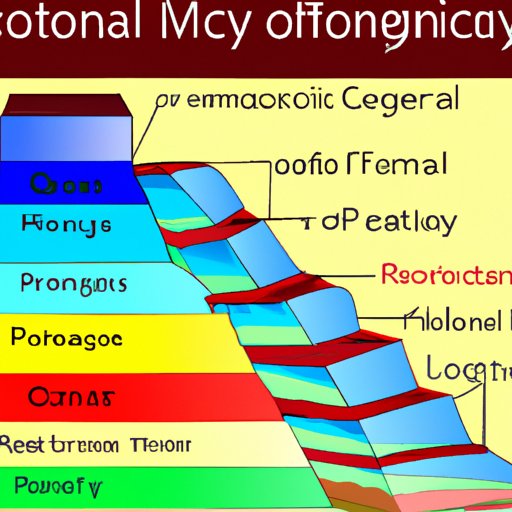Introduction
Geology is a branch of science that deals with the study of the Earth’s structure and history. It is the scientific study of the physical features of the Earth, its composition, and the processes that shape it. Geology also looks at the resources contained within the Earth, such as minerals, petroleum, and groundwater.
Exploring the Earth: What is Geology?
The Earth has a layered structure, with an inner core, an outer core, a mantle, and a lithosphere comprised of the crust and upper mantle. The layers are composed of different materials, such as iron, oxygen, silicon, and magnesium. Geologists study these layers and their composition in order to understand the Earth’s structure and how it has changed over time.
Geology also involves the study of geological processes. These processes include volcanism, mountain building, faulting, erosion, and sedimentation. These processes can create features on the Earth’s surface, such as mountains, valleys, canyons, and lakes. Geologists study these features to gain a better understanding of the Earth’s structure and history.
There are several types of geologic features. Structural features are created by deformation in rocks due to forces such as compression or tension. Igneous rocks form when molten material from the Earth’s interior cools and solidifies. Sedimentary rocks are formed from sediments that have been deposited by water, wind, or ice. Metamorphic rocks are formed when existing rocks are subjected to heat and pressure.
Geology: The Study of the Earth’s Structure and History
Geology involves the study of the Earth’s structure and history. Geologists use various methods to map the Earth’s surface, including aerial photography, satellite imagery, and field observations. This allows them to identify and map out geological features such as faults, folds, and igneous intrusions.
Stratigraphy is the study of the sequence and distribution of rocks in a particular area. By studying the relationships between different rock units, geologists can determine the age of the rocks and reconstruct the Earth’s history.
Fossils are another important tool for geologists. Fossils are the remains of plants and animals that lived in the past, and they can provide information about the environment and climate of the Earth at that time.
Investigating the Earth’s Surface Through Geology
Plate tectonics is the study of the movement of the Earth’s lithospheric plates. Plate tectonics explains the formation of mountain ranges, volcanoes, earthquakes, and ocean basins. Geologists use this knowledge to understand the evolution of the Earth’s surface.
Weathering and erosion are two other geological processes that shape the Earth’s surface. Weathering is the process by which rocks are broken down into smaller pieces. Erosion occurs when these smaller pieces are transported by water, wind, or ice. Geologists study these processes to understand how the Earth’s surface has changed over time.
Earthquakes are also studied by geologists. Earthquakes occur when energy stored in the Earth’s crust is released. By studying the patterns of seismic activity, geologists can gain insight into the structure of the Earth’s interior.
Geological Time: Looking at the Earth’s Past Through Geology
Geologists use various methods to date rocks and determine the age of the Earth. Radiometric dating is one method used to date rocks based on the decay of certain elements. Other methods, such as fossil correlation, can be used to compare the ages of different rocks.
The geologic time scale is a system used to divide the Earth’s history into different eras, periods, and epochs. This system helps geologists understand the sequence of events that have occurred in the Earth’s history.
Uncovering the Secrets of the Earth Through Geology
Geology is also used to explore the Earth’s resources. Mineral resources, such as gold and diamonds, are valuable economic commodities. Geologists search for these resources by mapping out areas where they might be located.
Petroleum and natural gas are two other important resources explored by geologists. Petroleum and natural gas are formed from the remains of ancient organisms, and geologists use seismic surveys to locate these deposits.
Groundwater is another resource investigated by geologists. Groundwater is an important source of drinking water, and geologists use various techniques to locate and assess the quality of groundwater resources.
Conclusion
Geology is the scientific study of the Earth’s structure and history. It examines the Earth’s surface, its processes, and its past, as well as the resources it contains. Geologists use various methods to map out the Earth’s surface, study its geological features, and uncover its secrets. Understanding geology helps us understand how the Earth works and how to use its resources.
(Note: Is this article not meeting your expectations? Do you have knowledge or insights to share? Unlock new opportunities and expand your reach by joining our authors team. Click Registration to join us and share your expertise with our readers.)
